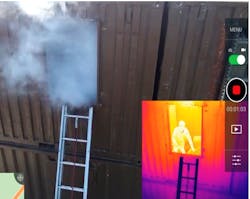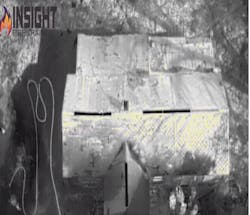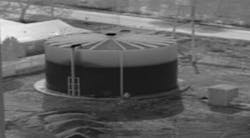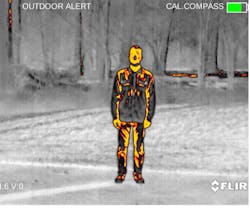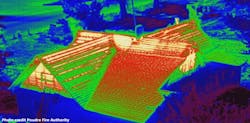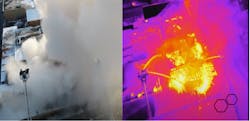Drone Thermography
The world of technology is moving at lightning speed, and nowhere is this pace more evident than in the drone market. It seems as if a new innovation, feature or product appears almost each week. However, these improvements might be outpacing the end user’s knowledge and understanding of the innovations.
Gradually, emergency services (fire, police, EMS, search and rescue) have been implementing unmanned aircraft systems (UAS), or drones, into their service delivery model successfully. FDNY, the Chula Vista, CA, Police Department and various departments in the state of Texas exemplify successful drone programs.
These organizations planned, trained and completed the proper certifications and compliance paperwork to operate their drone(s) in their intended context. However, very few of the organizations who use drones, no matter the type, have in-depth training regarding thermography. This leaves many skilled drone operator/pilots at a distinct disadvantage.
Thermography is used across the globe for the military, building inspection, research & development, industrial and medical uses, and more. Merriam-Webster defines thermography as “a technique for detecting and measuring variations in the heat emitted by various regions of the body and transforming them into visible signals that can be recorded photographically.”
That said, thermography isn’t limited to certain contexts. Ultimately, it’s limited by education and budget.
Thermography is divided further into two main types of usages: quantitative and qualitative.
Quantitative thermography is for specific temperature measurements, such as EBT (elevated body temperature) screenings or industrial inspections that involve small changes in temperature that could indicate problems or pending failures of expensive infrastructure/equipment.
Qualitative thermography is for identifying anomalies or specific areas of interest where exact temperature measurements aren’t critical. This type of thermography is used more commonly in emergency services, including fire and search and rescue. A trained operator/pilot can differentiate between a normal and an abnormal heat signature as well as the differences between solar loading versus an actual fire in a structure and thermal bridging. The same person also can note different roof types (and how this affects their image), key infrastructure (such as chimneys, vents, HVAC, etc.) and potential structural-integrity issues. An incident commander who has access to a live stream will find this real-time data extremely valuable for overall strategies and tactics.
At first glance, one might note similar color palette options in different brands of thermal-imaging-equipped drones. However, the temperature/color correlations might differ per brand because of manufacturers’ variance in detectors and the programming of their respective color palettes.
A key point to remember is that each color palette is designed for a specific context. Although some color palettes might look impressive, they might make the operator/pilot’s job more difficult.
Certain color palettes (i.e., Rainbow and High Color) might offer more contrast and more colors, but these typically are used when heat signatures appear absent, because they are intended for lower temperature environments. Color palettes that have fewer colors but that have stark differences between hot and cold (i.e., White Hot, Black Hot) will highlight specific areas of interest more easily and don’t overwhelm the operator.
When viewing the image that’s captured by a thermal imager, the operator/pilot must be aware that higher resolution detectors on the thermal imagers produce clearer images versus lower resolution detectors when paired with the proper lens.
The acronym that should be followed by an operator/pilot is DRI:
- Detect: Can the detector pick up the target?
- Recognize: Can the operator recognize what the target is?
- Identify: Can the operator specifically identify what the target is?
Each pixel is assigned a specific temperature. These individual pixel temperature points are assigned a color or shade. The specific colors in each palette correspond to the apparent surface temperature readings. Operator/pilots must know what temperature equates to what color associations. Not all color palettes equate to the same temperatures on different models/brands of drone detectors. It is with this knowledge that an operator/pilot can choose the correct color palette for the specific use.
The first variable in choosing the right color palette is the operator or the individual who is viewing the image. If that individual has difficulty seeing certain colors (i.e., color blindness), selection of the color palette must take that into account.
The second variable for color palette selection is the overall background or target image to be viewed. This can include such variables as weather (high heat, extreme cold, bodies of water, etc.). If the target that is being viewed or sought to be identified is similar in temperature to the overall background, the operator/pilot must choose a color palette that will help the specific target stand out. White Hot and Black Hot traditionally have been the most successfully used color palettes in search and rescue missions, but this doesn’t mean that they always should be used. Uniform temperatures or bland scenes are known to be troublesome for thermographers when attempting quick analysis. Isotherms or high contrasting color palettes might be a better option when dealing with smaller differences in temperatures. However, the operator/pilot must know that the closer the target temperature is to other surrounding objects in the scene, the more that might cause the operator/pilot to miss the target when viewing the image.
The third variable is incident dependent. The overall terrain can make a difference in each color palette for ease of interpretation. For example, Iron Bow is a very popular color palette for when the operator/pilot is viewing targets during a search for extreme heat differences. However, when flying over water, it can be very difficult to pick out small differences in this color palette. It might be beneficial to view the background shortly after take-off with several color palettes to determine which one provides the best clarity based on conditions. Certain color palettes have adjustable spans that allow the operator/pilot to highlight specific areas of interest with small amounts of color (such as a 98.6-degree-F human being). Beware of saturation in high-heat conditions, which diminishes low-sensitivity details.
White Hot. This color palette only consists of black, gray and white. Higher resolution detectors use varying shades of gray to provide greater contrast between objects for more discernible detail in the image.
Black Hot or Reverse Polarity. This color palette is designed for industrial applications. All target items that are hot appear black. A few hand-held fire service thermal imagers include this feature. However, this palette isn’t recommended for firefighting applications. It can be used for lost person searches, active violence incidents, and search and rescue.
White Hot and Black Hot are the most successfully used color palettes in search and rescue missions, because the operator/pilot can toggle between the two to look for minute differences in the image that might reveal the target, object or person.
Rainbow or High Color. Numerous manufacturers don’t publish the temperature/color correlations for this color palette, so if a color bar isn’t present on the side of the display, it can be difficult to remember or interpret these colors quickly. To complicate matters further, there are several versions of the Rainbow or High Color color palette, including Rain and Rainbow 2.
Although manufacturers often use this palette to impress clients or for demonstration purposes, thermography experts aren’t fond of it. The colorization of certain temperatures can be confusing as to which color is hotter or colder. That said, with proper training and education, this color palette can be particularly useful for roof inspections, container inspections and hazmat incidents. Rainbow typically is used for low-temperature and low-contrast analysis. Remember, a long-wavelength infrared (LWIR) detector doesn’t detect gases or smoke temperatures. The operator/pilot must be aware that when viewing a hazmat incident, although temperature differences on the surface might be detected, the vapor cloud or leak in totality won’t.
Isotherms. An isotherm is an application-based color palette that’s used in almost all thermal imaging cameras. The bottom and top of the temperature span is defined by the operator/pilot and anything that’s over a certain temperature shows up as a specific highlighted color. For example, setting up the isotherm to highlight superheated areas of a hazmat incident allows for better stream placement in defensive fire attack operations. An isotherm also can be useful to an operator/pilot for defining the edge of a fire line in a wildland fire, for locating hidden hot spots that otherwise would go unnoticed and for locating lost persons during a search and rescue.
Iron Bow or Fusion. This color palette is very popular among thermographers, because it’s very useful when viewing roofs, electrical substations, etc. It allows the operator/pilot to quickly identify high heat sources. This color palette isn’t recommended for search and rescue missions, because a person who is near the edge of the detection range can blend in or wash out, which can cause the operator/pilot to miss the victim.
Drones are the future of high-speed analysis of emergency incidents. However, innovation must be accompanied by education, or the same mistakes will be made in emergency incidents, just with more expensive equipment. Fire departments, police and emergency service providers must realize that mistakes that are made with these devices will be analyzed and re-assessed by professionals in a court of law.
Without proper education and training, color palettes can become a hindrance rather than benefiting the overall success of each mission. Operator/pilots can benefit from thermography-based trainings where the operator/pilot is taught to properly select and interpret each color palette with the full understanding of the benefits and limitations of thermography.
